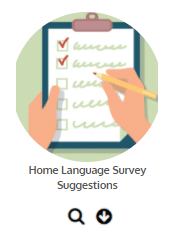We are happy to see that there is a lot in the news these days about the benefits of bilingualism. Society as a whole has generally shifted to the understanding that being bilingual is an advantage.

“Until about the 1960s, the conventional wisdom was that bilingualism was a disadvantage. Some of this was xenophobia. Thanks to science, we now know that the opposite is true…
I’m asked about this all the time. People e-mail me and say, ‘I’m getting married to someone from another culture, what should we do with the children?’ I always say, ‘You’re sitting on a potential gift.'”
Dr. Ellen Bialystok
The New York Times
However, when you enter the world of special education, where a child is potentially operating from a position of deficit, the advantages of bilingualism come back into question because we are routinely asked:
- Does being bilingual negatively impact a child’s communication?
- Should I stop speaking my native language with my child?
- Does he have a disorder or is he just learning a second language?
- What language should we use for testing?
- What language should we use to provide speech therapy?
Communication is Not Negatively Impacted by Bilingualism
The truth is that communication deficits are not caused by bilingualism. Communication deficits are also not made worse by bilingualism. Lastly, asking a bilingual family to only communicate in English can potentially have a negative impact on communication. If their English is less complex than their native language, think about the model the child is exposed to each day.
What about “The Silent Period” and “Delayed Acquisition of Sounds”
Of course, there is an adjustment period as people learn a second language. It is strange to expect perfection right out of the gate as far as bilingualism goes. We would never do this with any other form of “learning.”
For example: what was your penmanship like when you began to write? Were classmates of yours ahead of you? How far ahead of you are they now? Ultimately, after enough time, we learn to write effectively. I am dating myself here, but what if you learned one type of writing (print) and later began a second writing style (cursive). It would take you a while to get as proficient with your cursive before you could communicate as well as you do with script writing.
Yes, it took me longer to learn how to write both ways but now I can communicate by writing in two different ways whereas my poor script-only colleagues are relegated to one form of written expression! Just kidding. Does anyone actually use cursive anymore?
And! What if (like me) you were told your drawing and art skills were awful? And you quit. And you didn’t realize that everyone else also drew dogs that looked like toilet paper tubes with hairy tails.

And I guess they also didn’t tell you that everyone drew people that looked like burning marshmallows. Pardon me, Picasso. But I believed them. So I quit, and I still draw like a kindergartener.

Bilingualism is a Spectrum Like All Learning
As special educators, we can’t think that bilingualism only has one flavor – perfect. It is a spectrum that starts – not at an age – but at the time of exposure. Then, 3-5 years later they are speaking pretty well (BICS – Basic Interpersonal Communication Skills). 5-7 years later they are up and running academically (CALP = Cognitive Academic Language Proficiency).
Our job is to:
- Not put them into special education simply because they are bilingual.
- Not deny services or postpone testing until the child “figures it out.”
So, as speech language pathologists we need to see some research to share with other professionals and adults. These include doctors, administrators, teachers, and parents.
This isn’t always easy, and it’s confusing. In order to do it effectively we need four things:
- We need some research to share with our colleagues, parents, and doctors to upgrade their beliefs and knowledge about the benefits of bilingualism.
- We need a way to gather good information about the home language and amount of time the child has been exposed to English.
- We need a way to account for bilingualism when we are testing and writing goals.
- We need a way to account for bilingualism when we are doing therapy.
1. Research on the Benefits of Bilingualism
Here are a few resources that highlight the advantages of being bilingual and provide research to show that bilingual children have more cognitive flexibility in problem-solving skills and executive functions.
On the American Speech-Language Hearing Association (ASHA) website the advantages of bilingualism are laid out in a succinct manner. These advantages might include:
- Being able to learn new words easily
- Being able to use information in new ways
- Putting words into categories efficiently
- Quickly coming up with solutions to problems
- Good listening skills
- Connecting with others easily
A New York Times article called “Hearing Bilingual: How Babies Sort Out Language” also reported on the benefits of infants’ exposure to two languages based on research done at the University of Washington. “What the study demonstrates is that the variability in bilingual babies’ experience keeps them open,” said Dr. Patricia Kuhl, co-director of the Institute for Learning and Brain Sciences at the University of Washington and one of the authors of the study. “They do not show the perceptual narrowing as soon as monolingual babies do. It’s another piece of evidence that what you experience shapes the brain.”
2. Gathering Parent Information – Interviews vs. Questionnaires
What’s the best way to get information from parents about their child’s speech/language developmental history? Is it better to conduct an interview or give them a questionnaire to fill out?
The most reliable way to get information from parents is through an interview; either in person or over the phone. Parents often have difficulty understanding the questions on a questionnaire without examples or explanations. Their answers may be partially complete or difficult to interpret. In some cases, the literacy level of the parents can also make it difficult for them to complete the forms we send home. It is helpful to send home the paperwork and then call the parents to see if they need clarification or assistance in answering the questions. That way we are sure that they understand what information we are looking for and their responses are as complete and clear as possible. It also helps ensure that we get the questionnaires back and gives us another opportunity to make personal contact with the families of the children that we serve.
We have created some documents that you can download from our Evaluation Resource Page to get you started.
Can’t I just use the Home Language Survey?
We all get referrals for students with secondary language backgrounds and upon inquiring about language of dominance we are told to check the Home Language Survey. Never has a document carried so much weight and been so underfunded with current information. Why distrust the Home Language Survey?
- Most are completed when a child enters school (age 4) and not updated.
- Most are made up of 1-3 questions with no clarification questions asked.
- Most are only provided in English (figure that one out).
- Most are negatively framed rather than being neutral or considering the benefits of bilingualism.
How can we get more accurate information about language use?
Here are some questions we can ask:
- What language is the TV and/or radio set to?
- What language is used with the parents?
- Who else is living at the home? Older siblings are often fluent English speakers.
- What language is used in the classroom? If more than one, how much is each used?
- Who does the child hangout with and what do they speak with others?
Why do we want more accurate information about language use?
If students use different languages across different settings, what should we expect? We would expect different sets of vocabulary to exist in each language and different abilities to exist in each language. This is important information to gather when considering whether a child is impaired or just has a language difference. Here is some interesting related research.
- There is a high correlation between language exposure and vocabulary production (Pearson, Fernandez, Lewedeg, & Oller, 1997).
- Bilingual toddlers who are circumstantial bilinguals use approximately 30% of their concepts in both languages and 70% in one language or the other (Pearson, Fernandez & Oller, 1995).
- Young school-age bilinguals produce same # of category items in Spanish and English BUT 70% are unique to one language (Peña, Bedore & Zlatic, 2002).
- Culture is strongly tied to word use. School-age bilinguals listed different foods in Spanish than they did in English (Peña, Bedore & Zlatic, 2002).
- English-speaking parents use more nouns. First words of English speakers are typically nouns (Gentner, 1982; Nelson, 1973).
- Mandarin Chinese-speaking parents use more verbs. First words of their children are nouns and verbs (Tardif, 1995).
- Korean-speaking parents talk about activities more. First words of their children are nouns and verbs (Choi, 2001).
3. How do we account for bilingualism during speech language evaluations?
This is a more complex question but know that it is easily accomplished by monolingual SLPs everywhere. For example, I speak English and Spanish. I am still very confident testing in Farsi, Mandarin, Igbo! I may need an interpreter of course but I can totally pull it off. If you work with bilingual students, these resources will hone your skills:
Bilingualism Evaluation Essays
- Difference or Disorder? Speech Development in English Language Learners
- Write Speech Therapy Goals: The Write Stuff
Bilingualism Evaluation CEU Courses
- Difference or Disorder? Speech Development in English Language Learners
- Difference or Disorder? Language Development in English Language Learners
4. How do we account for bilingualism during speech therapy?
Another toughy but if you are up for changing your therapy up you will reduce the amount of planning you have to do and increase your student’s outcomes. Not joking.
Here’s where it gets better: We need to think long and hard about this idea of “accounting for.” What this means is that we need results and don’t want to muddy the waters or we don’t get the outcomes we want.

If you were a diet researcher, and you didn’t “account for” people raiding the fridge at night, your data and outcomes would not add up.
In speech therapy with diverse students, this means we have to account for:
- Second-language influence
- Cultural difference
- Prior exposure to therapy topics or experiences
We do this with curriculum-based and literacy-based intervention. Again, this is a huge topic but you can get up and running quite quickly.
Bilingualism Speech Therapy Essays
- Planning for Speech Therapy
- Quick Pre- Lesson Planning for Speech Therapy
- 30-minute speech therapy sessions
- Where Speech Therapy and Literacy Meet
- Literacy-Based Intervention for Speech-Language Therapy
- Justifying Language Therapy Games with Literacy
Bilingualism Speech Therapy CEU Courses
Bilingualism Speech Therapy Books
- Curriculum-based Speech Therapy Activities: Pre-K/K: English & Spanish Edition (Volumes 1&2)
- Literacy-Based Speech and Language Therapy Activities
Let’s conclude by circling back to the questions we began with because with the information above they become quite simple
Does being bilingual negatively impact a child’s communication?
No way.
Should I stop speaking my native language with my child?
Don’t even think of it. Here’s a full blog post just on that question.
Does he have a disorder or is he just learning a second language?
We need to test, and account for any languages mentioned in the questionnaire we are going to do.
What language should we test in?
We need to at least attempt to test in any language present in the home or the child might look like she has a disorder. Here’s a blog post about which language we should test in.
What language should we provide speech therapy in?
English works, but we are going to 1) use the classroom content so the child is familiar with it. We are 2) going to write goals around things that exist in both languages. For example, if both languages have /s/, that is a good articulation target. If both languages use pronouns, that is a good goal.
Good Resources on the Benefits of Bilingualism
- Bilingualism in Development: Language, Literacy and Cognition by Ellen Bialystok
- BICS and CALP: Clarifying the Distinction. Cummins, Jim





LOVE LOVE LOVE this! You have captured the essence of my soap box! Thank you.